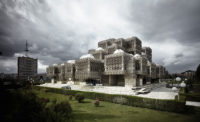Heroic: Concrete Architecture and the New Boston, by Mark Pasnik, Chris Grimley, and Michael Kubo. Monacelli Press, October 2015, 336 pages, $50.
“We had a shared preference for a monolithic architecture,” Henry N. Cobb, principal of Pei Cobb Freed & Partners, tells the authors of Heroic: Concrete Architecture and the New Boston. “We were enchanted by the idea that once the concrete was poured, the building was essentially finished because the architecture was already all there.”
At once history lesson and labor of love, Heroic explores how 1960s Boston came to be a showcase of unapologetic, often superscaled masonry modernism–from the rugged yet triumphant Boston City Hall to the machinelike efficiency of such projects by Cobb’s firm (then called I.M. Pei & Partners) as the vast Christian Science Center. There are interpretive essays, interviews with seven of the architects, and individual chapters on 25 of the era’s buildings; the selection goes beyond the obvious icons to include such discreet gems as Tad Stahl’s 70 Federal Street, a seven-story grid of glass and concrete that is more intuitively contextual than anything built during the faux-historic 1980s.
The book’s editors and principal authors–Mark Pasnik, Michael Kubo, and Chris Grimley–run the Boston design firm over,under. They began what they call their “Heroic Project” in 2007, when then-mayor Thomas Menino proposed demolishing City Hall and selling the land to developers. That absurd threat receded, but the trio has continued its quest to raise public appreciation of built artifacts from an era when architects “sought to imagine a stronger civic society.”
If you’re at all susceptible to the sculptural power of a structure like Kallman, McKinnell & Knowles’s Boston City Hall of 1968 (I plead guilty), Heroic will resonate. The contemporary photographs are startling, and the narratives persuasively capture the spirit of an era when power brokers like Mayor John Collins and Boston Redevelopment Authority director Edward Logue poured resources and creative ambitions into reviving the metropolis.
But like anyone in love, the trio is blind to its loved one’s flaws. While Grimley, Kubo, and Pasnik excel at conveying the deft touches in these large buildings, such as the notched interconnections for the girders and beams of Kallman and McKinnell’s 1,850-car garage at Government Center, they barely acknowledge the underlying reasons for the backlash to urban-renewal-scaled “heroism”—it felt alien and destructive in a city with a heritage of small blocks and fine-grain building materials. Fortunately, some of the essayists are more discerning: City Hall might have captivated Ada Louise Huxtable, but Joan Ockman points out that “to a significant portion of the general public, what it flagrantly represented was the hubris of governmental power and an assault on humanistic conceptions of urban life.”
In retrospect, architects interviewed see this too. As Cobb noted, “The era reflected a moment of willingness to undertake the reshaping of the city at a scale which today would be absolutely unthinkable. Maybe it should have been unthinkable back then, but it wasn’t.”





Post a comment to this article
Report Abusive Comment